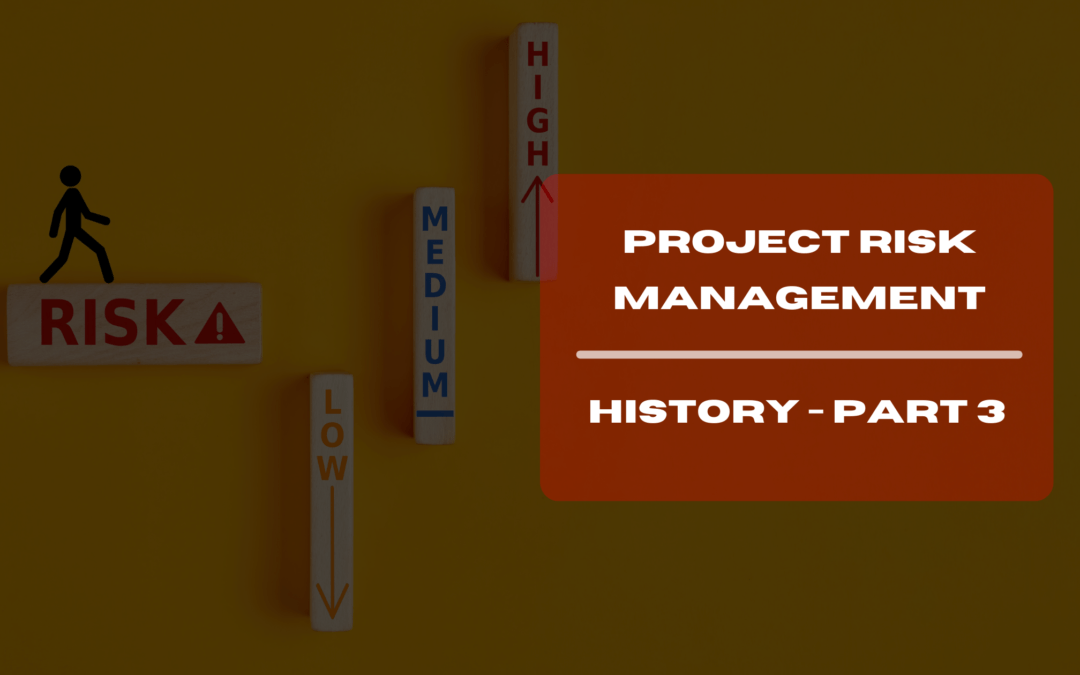The history of Project Risk Management: Part 3
Welcome back to the third installment of our exploration into the historical context of project risk management in the construction industry. In Parts 1 and 2, we delved into the origins of risk management, the challenges it has faced throughout history, and the development of various models to assess construction project risks.
If you want to refer them, you can read them here:
The Roots of Project Risk Management: Part 1
The Roots of Project Risk Management: Part 2
Now, let’s dive deeper into the methodologies of risk management and their evolutionary significance.
Table of Contents
Methodologies of Risk Management
As the complexity of construction projects grew, so did the need for systematic approaches to risk management. Various methodologies have emerged, each offering unique tools and techniques to identify, assess, and mitigate risks. Here, we’ll take a closer look at some of these methodologies:
- Project Management Institute’s (PMI) Project Risk Management Process: PMI’s framework outlines a structured approach to risk management, including risk identification, qualitative and quantitative risk analysis, risk response planning, and risk monitoring and control. It provides a comprehensive roadmap for integrating risk management into project planning and execution.
- International Organization for Standardization (ISO) ISO 31000: ISO 31000 is a global standard for risk management that applies to all types of organizations, including construction projects. It emphasizes the importance of risk culture, risk assessment, and risk treatment. ISO 31000 provides a holistic approach to managing risk at all levels of an organization.
- Bowtie Analysis: Originally developed for safety management in high-risk industries, Bowtie Analysis has found application in construction. It uses a visual representation resembling a bowtie to assess risks, identify preventive and mitigative barriers, and visualize their interrelationships.
- Root Cause Analysis (RCA): RCA is a problem-solving methodology that aims to identify the underlying causes of risks and incidents. By addressing root causes, construction teams can implement effective preventive measures to reduce the likelihood of recurrence.
- Failure Mode and Effects Analysis (FMEA): FMEA, initially developed in the automotive industry, has been adapted for construction. It involves systematically identifying failure modes, assessing their potential impact, and ranking risks based on severity, occurrence, and detectability.
Evolutionary Significance of Methodologies
The development and adoption of these methodologies signify a paradigm shift in construction project management. Here’s why they are of utmost importance:
- Improved Decision-Making: Methodologies provide a structured approach to risk management, enabling project teams to make informed decisions. By systematically assessing risks and their potential impacts, teams can allocate resources more effectively and prioritize risk response actions.
- Enhanced Predictability: In an industry notorious for project delays and cost overruns, methodologies offer a level of predictability. They allow project managers to anticipate potential risks and develop contingency plans, reducing the likelihood of surprises.
- Holistic Approach: Methodologies like ISO 31000 emphasize a holistic approach to risk management that extends beyond individual projects. They encourage organizations to embed risk management into their culture, promoting proactive risk identification and mitigation.
- Continuous Improvement: Root Cause Analysis and lessons learned from past projects facilitate continuous improvement. By analyzing the causes of risks and incidents, construction teams can implement preventive measures and refine their processes over time.
- Regulatory Compliance: Many industries, including construction, face increasing regulatory requirements related to risk management. Methodologies like ISO 31000 provide a framework for meeting these compliance standards.
In conclusion, the methodologies of risk management in construction mark a significant advancement in the field. They empower project managers, stakeholders, and organizations to navigate the complexities of construction projects more effectively. By adopting these methodologies, professionals in the construction industry can enhance their performance, reduce uncertainties, and contribute to the successful delivery of projects.
As we wrap up this journey into the historical roots of project risk management, we hope you’ve gained a deeper appreciation for the discipline’s evolution. The history of risk management in construction is a testament to human ingenuity and adaptability, and it continues to shape the industry in profound ways.
In the concluding part of “The Roots of Project Risk Management,” we’ll summarize key takeaways and explore how the historical context informs modern practices. We’ll also discuss the importance of understanding this history for both students and professionals in the construction project management field.
Thank you for joining us on this enlightening exploration of project risk management through the ages.

